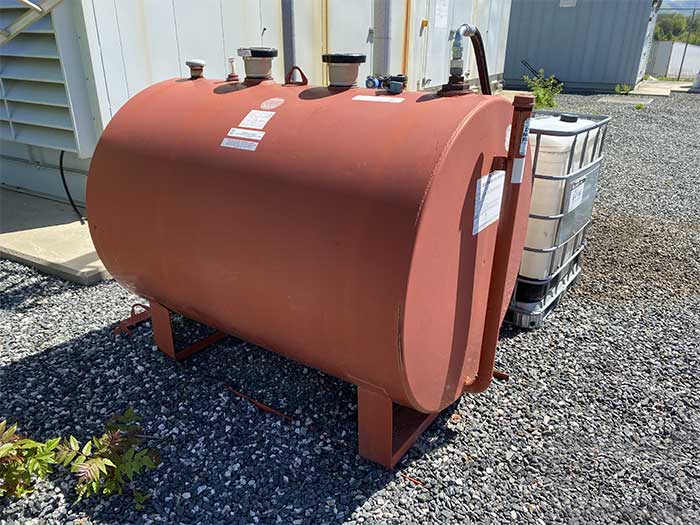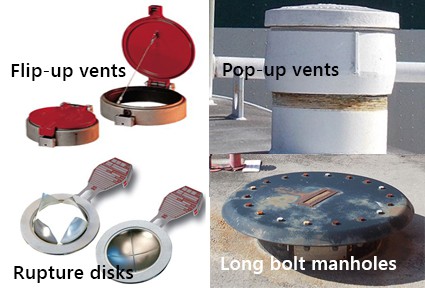


Unexpectedly replacing a tank can strain your budget and always seems to come at the most inopportune times. Based on my experience with tank inspections, one of the most common reasons for unexpected tank replacements is using an Underground Storage Tank (UST) as an Aboveground Storage Tank (AST).
Any STI/SPFA SP001 Certified Inspector can identify a misused UST during the required periodic inspections of ASTs, and these tanks are also commonly discovered during site visits related to drafting or updating Spill Prevention, Control, and Countermeasure (SPCC) Plans. Budget and complete a tank replacement before your next inspection. During my inspections, I use three indicators when looking at a tank to identify if a UST is misused as an AST:
No Emergency Vent! The most important reason not to use a UST aboveground.
If the unthinkable happens and you have a fire around your tank without proper emergency venting, that tank fire can go from bad to BOOM!
The design of ASTs is to minimize the danger of being engulfed in flames to release the vapors from the tank in a controlled manner. In contrast, a UST design will never be engulfed in flames, so the tank manufacturer does not install an emergency vent port.
Properly sizing an AST emergency vent to release the increased vapor pressure during a fire is important, too. The need to release the higher pressure makes emergency vents much larger than the normal vents for simple atmospheric changes. The larger emergency vents come in five varieties:

Flip-up vents are spring-loaded caps held closed by a latch designed to release at a set pressure or temperature. If the latch doesn’t work and the flip-up cap is open, duct tape or a well-placed brick is not the proper solution; you’ll need to replace the latch. Luckily, the latches are readily available, and the latch installation is usually simple.
Rupture disks are vent covers where the entire cover breaks open when a set pressure or temperature is exceeded, instead of just the latch like in the flip-up vents.
Pop-up vents are weighted caps that sit on the vent until the pressure in the tank reaches the designed level. During fire incidents, these vents periodically release the built-up vapors, preventing the tank from rupturing. If this vent is not staying seated correctly, repair or replace the vent.
Long bolt manholes function similarly to the pop-up vents to periodically release built-up vapors. This type of vent relies on the bolts securing the manhole cover to have the designed amount of slack between the manhole rim and the nuts. I’ve seen too many long bolt manholes with the nuts fully tightened to the rim, completely negating the vent’s purpose and safety. A simple fix for this issue is to replace the fully threaded bolts with properly sized partially threaded bolts.
New tanks are unlikely to have Weak Roof-to-Shell joints. Occasionally, I’ve seen them in older single-wall vertical tanks, where the roof construction has a particular area break when the tank pressure gets too high.

Unreviewed Damage: Most USTs as ASTs are old and damaged
Frequently pulling these tanks results in dents or scraps to the UST. Remove any damaged tanks from service until a qualified inspector or engineer can review the damage. Additionally, most states prohibit the reuse of USTs once they are removed from their original installation location.
It may be difficult to see in this image, but the tank is scratched, dented, and starting to rust.
 No Tank Saddles
No Tank Saddles
Most of the repurposed USTs are horizontal, so these tanks require chocks or an earthen berm to keep them in place. Saddles act as the welded attachment areas for the tank legs and distribute the weight over the tank’s belly — part of the AST design. Sometimes, people with good intentions get too creative and attempt to turn a UST into a vertical AST. However, the presence of vent connections along the side of the tank and none on the tank top is a sure sign the tank is not in use appropriately.
Best practice — look for these warning signs before inspections and drafting or updating SPCC Plans.
 About the Author: Benjamin Reynolds is a Senior Project Professional in our Little Rock, Arkansas, office. His recent experience includes serving as a Technical Branch Manager for the Arkansas Department of Environmental Quality where he led a team of engineers, toxicologists, and site assessors to review and guide site assessments and remediation projects throughout the state. He is experienced in Phase I and Phase II Environmental Site Assessments, as well as Spill Prevention, Control, and Countermeasures (SPCC) Plans, and Storm Water Pollution Prevention Plans (SWPPPs). He is a Professional Engineer licensed in Arkansas, Oklahoma, and Tennessee. Reach out to Ben at or on LinkedIn.
About the Author: Benjamin Reynolds is a Senior Project Professional in our Little Rock, Arkansas, office. His recent experience includes serving as a Technical Branch Manager for the Arkansas Department of Environmental Quality where he led a team of engineers, toxicologists, and site assessors to review and guide site assessments and remediation projects throughout the state. He is experienced in Phase I and Phase II Environmental Site Assessments, as well as Spill Prevention, Control, and Countermeasures (SPCC) Plans, and Storm Water Pollution Prevention Plans (SWPPPs). He is a Professional Engineer licensed in Arkansas, Oklahoma, and Tennessee. Reach out to Ben at or on LinkedIn.